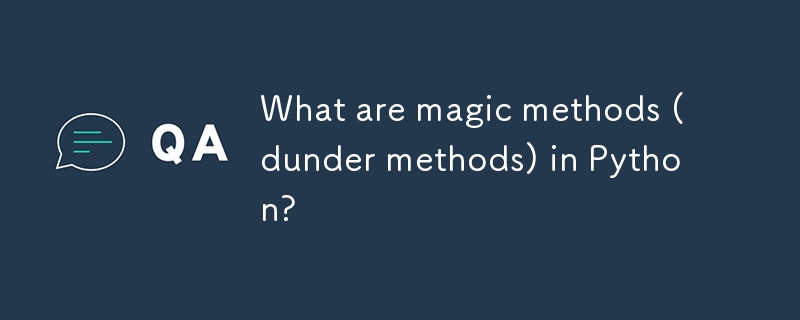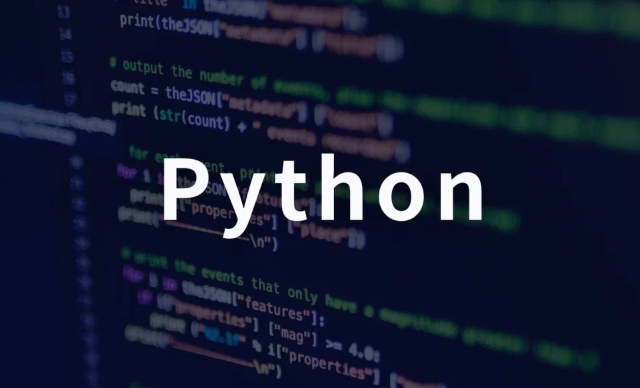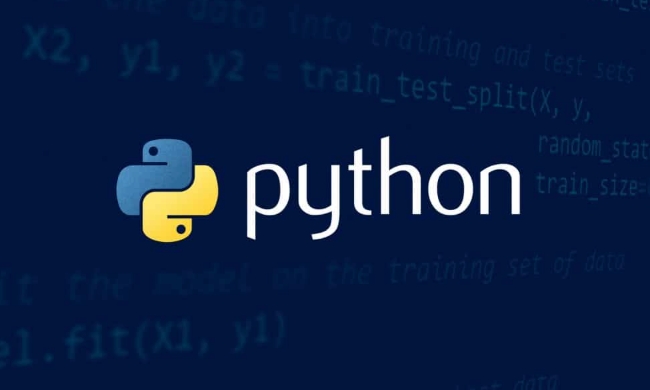Magic methods (dunder methods) in Python are special methods used to customize object behavior. They start and end with a double underscore, such as __init__ or __str__, and are automatically triggered when a specific syntax or built-in function is used. 1. __init__ is used to initialize the object; 2. __str__ and __repr__ define the readable string representation and reconstructible expression of the object respectively; 3. __add__, __sub__, etc. define the addition and subtraction behaviors; 4. __eq__, __lt__ and other control comparison operations. Implementing these methods, such as adding __add__ to custom class Point to support operations, makes the class behave more naturally and in line with expectations. When using it, you should pay attention to the reasonable return type, avoid modifying the original object, dealing with error types, and maintaining intuitive design.

In Python, magic methods—also known as dunder methods (short for "double underscore")—are special methods that let you customize how your objects behave in various operations. These aren't meant to be called directly like regular methods; instead, they're triggered automatically when certain syntax is used or built-in functions are applied.

What makes dunder methods special?
They're surrounded by double underscores, like __init__ or __str__ , and they let you define behaviors for your objects that integrate with Python's core features. For example, when you use the operator on two custom objects, a specific dunder method ( __add__ ) is what determines how that addition works.
Commonly Used Dunder Methods
Here are some of the most frequently used ones:

Object Initialization :
__init__– This is the constructor method, called after the object is created. It's where you usually set up your instance attributes.-
String Representation :
__str__– Called by thestr()function andprint(). It should return a readable string representation of the object.
__repr__– Called byrepr(). Should be a valid Python expression that could recreate the object.
Arithmetic Operations :
__add__– Defines behavior for the
__sub__– Defines behavior for the-operator.
There are also__mul__,__truediv__, and more.Comparison Operators :
__eq__– Equal (==).
__lt__– Less than ().<br> And others like <code>__gt__,__le__, etc.
These are just a few examples. Each one gives you control over how your class interacts with standard operators and functions.
How to Use Dunder Methods Effectively
Let's say you have a simple class like this:
class Point:
def __init__(self, x, y):
self.x = x
self.y = y If you create two instances and try to add them using , you'll get an error. That's because Python doesn't know how to handle it unless you define __add__ .
You can fix that by adding:
def __add__(self, other):
return Point(self.x other.x, self.y other.y) Now when you do something like p1 p2 , it will work as expected and return a new Point .
A few tips:
- Make sure the return type makes sense for your use case.
- Don't modify the original objects unless that's intentional.
- Consider handling incorrect types gracefully, maybe by returning
NotImplemented.
Also, don't overdo it. Just because you can override behavior doesn't mean you always should. Keep things intuitive.
When Are Dunder Methods Called?
Most of the time, you won't call them directly like obj.__str__() . Instead, Python calls them behind the scenes.
For example:
-
len(obj)triggers__len__ -
str(obj)triggers__str__ -
obj[key]triggers__getitem__
Some are required if you want to support certain interfaces. Like if you want your class to work in a for loop, you'll need to implement __iter__ and __next__ (or delegate to another iterable).
One thing to note: some dunder methods are optional. If you don't define them and someone tries to use them, Python will raise an error.
Dunder methods give you fine-grained control over how your objects interact with Python's syntax and built-in functions. They make classes feel more natural to use and help avoid clunky APIs.
Once you understand a few key ones, it becomes easier to write classes that “just work” the way users expect.
And honestly, once you've defined __repr__ or __add__ for a class, you start wondering how you ever lived without them.
Basically that's it.
The above is the detailed content of What are magic methods (dunder methods) in Python?. For more information, please follow other related articles on the PHP Chinese website!

Hot AI Tools

Undress AI Tool
Undress images for free

Undresser.AI Undress
AI-powered app for creating realistic nude photos

AI Clothes Remover
Online AI tool for removing clothes from photos.

Clothoff.io
AI clothes remover

Video Face Swap
Swap faces in any video effortlessly with our completely free AI face swap tool!

Hot Article

Hot Tools

Notepad++7.3.1
Easy-to-use and free code editor

SublimeText3 Chinese version
Chinese version, very easy to use

Zend Studio 13.0.1
Powerful PHP integrated development environment

Dreamweaver CS6
Visual web development tools

SublimeText3 Mac version
God-level code editing software (SublimeText3)
 PHP calls AI intelligent voice assistant PHP voice interaction system construction
Jul 25, 2025 pm 08:45 PM
PHP calls AI intelligent voice assistant PHP voice interaction system construction
Jul 25, 2025 pm 08:45 PM
User voice input is captured and sent to the PHP backend through the MediaRecorder API of the front-end JavaScript; 2. PHP saves the audio as a temporary file and calls STTAPI (such as Google or Baidu voice recognition) to convert it into text; 3. PHP sends the text to an AI service (such as OpenAIGPT) to obtain intelligent reply; 4. PHP then calls TTSAPI (such as Baidu or Google voice synthesis) to convert the reply to a voice file; 5. PHP streams the voice file back to the front-end to play, completing interaction. The entire process is dominated by PHP to ensure seamless connection between all links.
 How to use PHP combined with AI to achieve text error correction PHP syntax detection and optimization
Jul 25, 2025 pm 08:57 PM
How to use PHP combined with AI to achieve text error correction PHP syntax detection and optimization
Jul 25, 2025 pm 08:57 PM
To realize text error correction and syntax optimization with AI, you need to follow the following steps: 1. Select a suitable AI model or API, such as Baidu, Tencent API or open source NLP library; 2. Call the API through PHP's curl or Guzzle and process the return results; 3. Display error correction information in the application and allow users to choose whether to adopt it; 4. Use php-l and PHP_CodeSniffer for syntax detection and code optimization; 5. Continuously collect feedback and update the model or rules to improve the effect. When choosing AIAPI, focus on evaluating accuracy, response speed, price and support for PHP. Code optimization should follow PSR specifications, use cache reasonably, avoid circular queries, review code regularly, and use X
 python seaborn jointplot example
Jul 26, 2025 am 08:11 AM
python seaborn jointplot example
Jul 26, 2025 am 08:11 AM
Use Seaborn's jointplot to quickly visualize the relationship and distribution between two variables; 2. The basic scatter plot is implemented by sns.jointplot(data=tips,x="total_bill",y="tip",kind="scatter"), the center is a scatter plot, and the histogram is displayed on the upper and lower and right sides; 3. Add regression lines and density information to a kind="reg", and combine marginal_kws to set the edge plot style; 4. When the data volume is large, it is recommended to use "hex"
 PHP integrated AI emotional computing technology PHP user feedback intelligent analysis
Jul 25, 2025 pm 06:54 PM
PHP integrated AI emotional computing technology PHP user feedback intelligent analysis
Jul 25, 2025 pm 06:54 PM
To integrate AI sentiment computing technology into PHP applications, the core is to use cloud services AIAPI (such as Google, AWS, and Azure) for sentiment analysis, send text through HTTP requests and parse returned JSON results, and store emotional data into the database, thereby realizing automated processing and data insights of user feedback. The specific steps include: 1. Select a suitable AI sentiment analysis API, considering accuracy, cost, language support and integration complexity; 2. Use Guzzle or curl to send requests, store sentiment scores, labels, and intensity information; 3. Build a visual dashboard to support priority sorting, trend analysis, product iteration direction and user segmentation; 4. Respond to technical challenges, such as API call restrictions and numbers
 python list to string conversion example
Jul 26, 2025 am 08:00 AM
python list to string conversion example
Jul 26, 2025 am 08:00 AM
String lists can be merged with join() method, such as ''.join(words) to get "HelloworldfromPython"; 2. Number lists must be converted to strings with map(str, numbers) or [str(x)forxinnumbers] before joining; 3. Any type list can be directly converted to strings with brackets and quotes, suitable for debugging; 4. Custom formats can be implemented by generator expressions combined with join(), such as '|'.join(f"[{item}]"foriteminitems) output"[a]|[
 python connect to sql server pyodbc example
Jul 30, 2025 am 02:53 AM
python connect to sql server pyodbc example
Jul 30, 2025 am 02:53 AM
Install pyodbc: Use the pipinstallpyodbc command to install the library; 2. Connect SQLServer: Use the connection string containing DRIVER, SERVER, DATABASE, UID/PWD or Trusted_Connection through the pyodbc.connect() method, and support SQL authentication or Windows authentication respectively; 3. Check the installed driver: Run pyodbc.drivers() and filter the driver name containing 'SQLServer' to ensure that the correct driver name is used such as 'ODBCDriver17 for SQLServer'; 4. Key parameters of the connection string
 python pandas melt example
Jul 27, 2025 am 02:48 AM
python pandas melt example
Jul 27, 2025 am 02:48 AM
pandas.melt() is used to convert wide format data into long format. The answer is to define new column names by specifying id_vars retain the identification column, value_vars select the column to be melted, var_name and value_name, 1.id_vars='Name' means that the Name column remains unchanged, 2.value_vars=['Math','English','Science'] specifies the column to be melted, 3.var_name='Subject' sets the new column name of the original column name, 4.value_name='Score' sets the new column name of the original value, and finally generates three columns including Name, Subject and Score.
 Optimizing Python for Memory-Bound Operations
Jul 28, 2025 am 03:22 AM
Optimizing Python for Memory-Bound Operations
Jul 28, 2025 am 03:22 AM
Pythoncanbeoptimizedformemory-boundoperationsbyreducingoverheadthroughgenerators,efficientdatastructures,andmanagingobjectlifetimes.First,usegeneratorsinsteadofliststoprocesslargedatasetsoneitematatime,avoidingloadingeverythingintomemory.Second,choos







